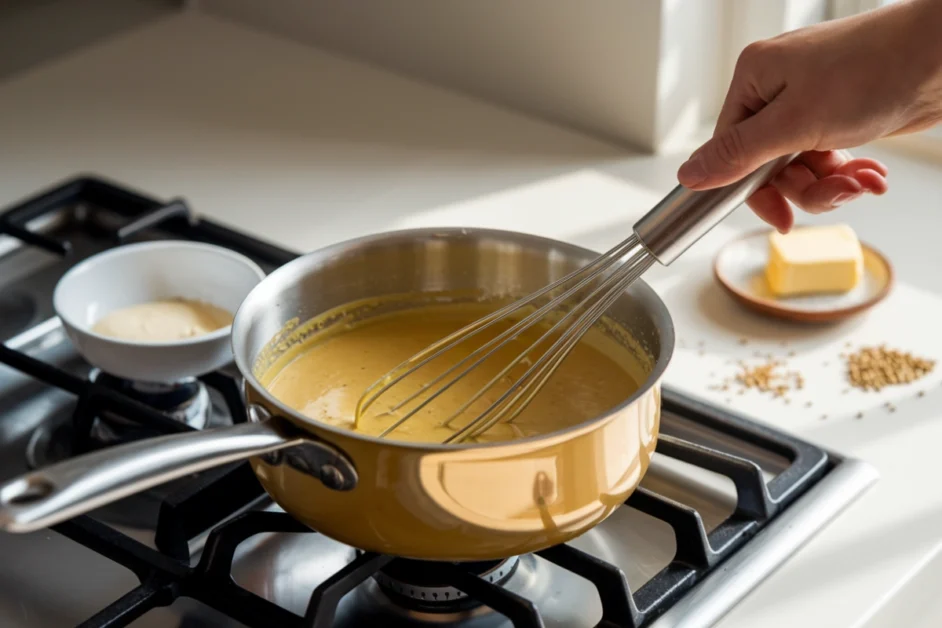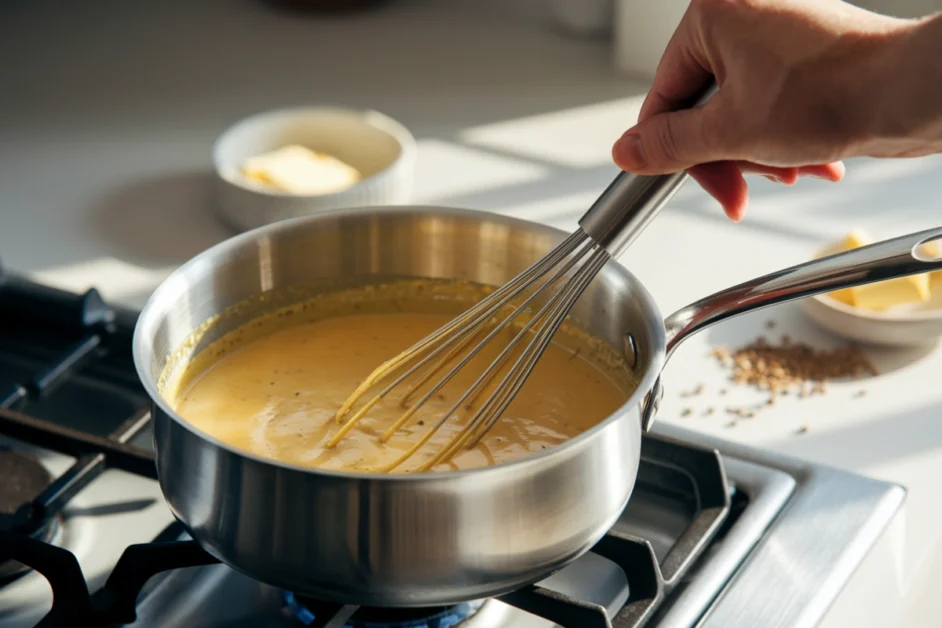Mustard sauce is a versatile condiment that adds flavor to many dishes. However, sometimes you might find that the sauce is too thin for your liking. Knowing how to thicken mustard sauce can make all the difference in achieving the perfect consistency for your culinary creations. This guide will walk you through various methods to thicken mustard sauce, ensuring it’s just right for any dish.
Why You Might Need to Thicken Mustard Sauce
There are several reasons why you might need to thicken mustard sauce. For instance, some dishes require a thicker sauce to cling better to the food. Other times, you might simply prefer a more substantial texture. Understanding how to thicken mustard sauce allows you to adjust the consistency to your liking, whether for dipping, spreading, or drizzling.
Moreover, thicker sauces can add a richer mouthfeel to your dishes. You may want to explore some basic techniques or experiment with more advanced methods, depending on the desired outcome. If you’re using mustard sauce for something like an old fashioned mustard sauce for tuna loaf, having the right consistency is crucial.
Basic Techniques to Thicken Mustard Sauce
1. Reduction
One of the simplest ways to thicken mustard sauce is through reduction. This method involves simmering the sauce to evaporate some of the liquid, naturally thickening the sauce over time. Here’s how you can do it:
- Step 1: Pour your mustard sauce into a saucepan.
- Step 2: Heat the sauce over medium heat.
- Step 3: Allow the sauce to simmer gently, stirring occasionally.
- Step 4: Continue simmering until the sauce reaches the desired consistency.
Reduction is a slow process, but it’s effective. It also intensifies the flavor, making it more robust. If you’re looking for a straightforward way to thicken mustard sauce without adding any additional ingredients, this method is ideal.
2. Adding a Thickening Agent
Another common method to thicken mustard sauce is by using a thickening agent. This method is quick and effective. Here are some common thickening agents you can use:
- Flour: Mix a small amount of flour with cold water to create a slurry. Slowly whisk this into your mustard sauce while it’s simmering until it thickens.
- Cornstarch: Similar to flour, cornstarch is mixed with cold water to form a slurry. It thickens more quickly than flour, so you only need a little.
- Arrowroot: This is a gluten-free alternative to flour and cornstarch. It works well in mustard sauce and provides a clear, glossy finish.
Adding a thickening agent is a fast way to achieve the desired thickness. However, it’s essential to add it gradually and stir continuously to avoid clumps. You can find more detailed instructions on using these agents in the Thicken Sauce 3 Ways guide by Allrecipes.
3. Incorporating Cream or Butter
If you prefer a richer, creamier mustard sauce, incorporating cream or butter can help achieve the desired thickness. Here’s how:
- Step 1: Slowly stir in heavy cream or butter into your simmering mustard sauce.
- Step 2: Continue to stir until the cream or butter is fully incorporated and the sauce thickens.
- Step 3: Simmer the sauce for a few more minutes to reach the right consistency.
This method not only thickens the sauce but also adds a luxurious texture. It’s perfect for sauces meant to accompany meats or vegetables, like those found in other classic recipes.
Advanced Techniques to Thicken Mustard Sauce
1. Using Eggs for Emulsification
For a velvety, thick mustard sauce, you can use eggs. Emulsifying the sauce with egg yolks adds richness and thickness. Here’s the process:
- Step 1: In a separate bowl, whisk together egg yolks.
- Step 2: Gradually add a small amount of hot mustard sauce to the yolks, whisking continuously to temper the eggs.
- Step 3: Slowly pour the egg mixture back into the saucepan, whisking as you go.
- Step 4: Heat the sauce gently until it thickens, ensuring it doesn’t boil.
This method requires careful attention to avoid curdling the eggs. However, the result is a smooth, creamy mustard sauce perfect for gourmet dishes.
2. Adding Pureed Vegetables or Nuts
For a thicker, heartier mustard sauce, pureed vegetables or nuts can be used. Potatoes, cauliflower, or cashews are great options. Here’s how to do it:
- Step 1: Cook your chosen vegetable or nuts until soft.
- Step 2: Puree them in a blender until smooth.
- Step 3: Stir the puree into your mustard sauce, and heat until combined and thickened.
This method not only thickens the sauce but also adds a depth of flavor. It’s ideal for those looking to enhance the nutritional profile of their sauce while achieving the desired consistency.
3. Creating a Roux-Based Mustard Sauce
A roux is a classic thickening method used in many sauces. It’s a combination of fat (usually butter) and flour, cooked together before being added to the sauce. Here’s how to create a roux-based mustard sauce:
- Step 1: In a saucepan, melt butter over medium heat.
- Step 2: Stir in an equal amount of flour, cooking until it forms a smooth paste.
- Step 3: Gradually whisk in your mustard sauce, stirring continuously until it thickens.
This method is particularly useful for creating a rich, smooth sauce with a bit more body. It’s a traditional technique that yields consistent results and is often used in recipes that require a robust sauce texture.
Common Issues and Solutions When Thickening Mustard Sauce

1. Fixing Too Thick Mustard Sauce
Sometimes, in the process of thickening, your sauce might become too thick. Here’s how to fix it:
- Add more liquid: Gradually add more of the base liquid (water, broth, or vinegar) while stirring until the sauce reaches the desired consistency.
- Use a whisk: A whisk can help smoothly incorporate the liquid into the thick sauce, preventing clumps.
2. Avoiding Clumps When Thickening
Clumps can be a common issue when thickening sauces, especially when using flour or cornstarch. To avoid this:
- Always create a slurry: Mix your thickening agent with cold water before adding it to the hot sauce.
- Stir continuously: Keep the sauce moving as you add the thickener to prevent clumps from forming.
If clumps do occur, you can strain the sauce through a fine mesh sieve to remove them.
3. Maintaining Flavor While Thickening
When thickening mustard sauce, it’s important to maintain the balance of flavors. Here are some tips:
- Adjust seasonings: After thickening, taste the sauce and adjust the seasonings if necessary. You may need to add more mustard, salt, or other spices.
- Consider the thickener’s impact: Some thickeners can mute flavors, so be prepared to tweak the seasoning to keep the sauce flavorful.
you might also want to read this article about What Are the Main Ingredients in Sloppy Joe?
Frequently Asked Questions (FAQs)
1. What is the best thickening agent for mustard sauce?
The best thickening agent depends on your preference. Flour and cornstarch are common choices, while arrowroot is great for a gluten-free option. Each has its unique properties and works well for different textures.
2. Can I thicken mustard sauce without flour?
Yes, you can thicken mustard sauce without flour. Cornstarch, arrowroot, and pureed vegetables are excellent alternatives. These options work well if you want to avoid gluten or prefer a different texture.
3. How long should I reduce mustard sauce for thickening?
The time it takes to reduce mustard sauce depends on the amount of liquid and the desired thickness. Generally, simmering for 10-20 minutes should achieve noticeable thickening. Keep the sauce at a gentle simmer and stir occasionally.
4. What can I do if my sauce gets too thick?
If your sauce becomes too thick, simply add more of the base liquid (such as water, broth, or vinegar). Add it gradually while stirring until the sauce reaches the desired consistency.
5. Can I freeze mustard sauce after thickening it?
Yes, you can freeze mustard sauce after thickening it. However, the texture may change slightly upon thawing. To restore the consistency, you may need to whisk it well or add a little liquid.
Conclusion: Achieving the Perfect Mustard Sauce Consistency
In conclusion, learning how to thicken mustard sauce opens up a world of culinary possibilities. Whether you choose to reduce the sauce, add a thickening agent, or use more advanced techniques like emulsifying with eggs, the key is to find the method that best suits your needs.
Remember to experiment with different methods and adjustments until you achieve the perfect consistency. Whether you’re preparing a mustard sauce for dipping, drizzling, or spreading, these techniques will help you create a sauce that’s just right for your dish.
For further details on thickening sauces, you can refer to Thicken Sauce Without Flour by McCormick, which offers more insights into alternative thickening methods.
